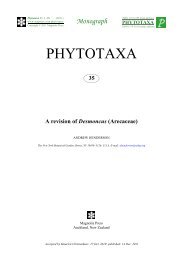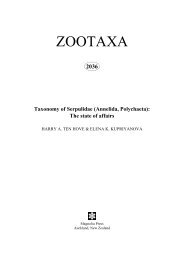Create successful ePaper yourself
Turn your PDF publications into a flip-book with our unique Google optimized e-Paper software.
technological shift from sailing vessels to steamships. The company did not recover. An 1878 attempt to transform<br />
the South Sea business into a shareholder corporation (“Deutsche Handels- und Plantagen-Gesellschaft der Südsee-<br />
Inseln zu Hamburg”; DHPG) could not turn the tide. A proposed government bailout by the German Empire,<br />
discussed with Chancellor Otto von Bismarck in early 1879, did not come to pass. By December 1879 Godeffroy &<br />
Sons was insolvent and stopped paying off its substantial bank loans (Hertz 1922: 59). The previously generous<br />
support for the Museum Godeffroy ended as well.<br />
Various aspects of the history of the Godeffroy family, its company, and its museum has been chronicled in<br />
several publications (e.g., Evenhuis 2007; Hertz 1922; Hoffmann 2000; Kranz 2005; Scheps 2005, 2010; Schmack<br />
1938; Spoehr 1963), most of these in German.<br />
Godeffroy specimen collectors<br />
Godeffroy accelerated the collecting activities not only by encouraging the existing captains and crews of his<br />
vessels to obtain material, but also through targeted employment of dedicated contract collectors<br />
(“Auftragssammler”). In addition to the quest for natural history and ethnographic items, the company asked these<br />
collectors to pursue economically interesting avenues, to investigate potential sources for tropical woods, for<br />
instance, or to look into the feasibility of pearlfishing by net (Scheps, 2005: 75). The contract collectors, often<br />
experienced travelers and naturalists with a particular interest in the target region, were a very international and<br />
eclectic group (Figs. 3–10). The editors of the Godeffroy Museum publications, Schmeltz and Friederichsen, and<br />
some subsequent authors (especially Kranz 2005 and Scheps 2005) reported in much detail on their persons and<br />
activities. Among the key figures were:<br />
Eduard Graeffe (1833–1916; also spelled “Gräffe”; Fig. 6), a PhD zoologist from Zürich, Switzerland.<br />
Originally hired as the collection’s first curator, after a short time helping set up the museum in Hamburg, Graeffe<br />
traveled to Samoa in October 1861 to head up the operations there. He collected extensively in Samoa and<br />
throughout the South Pacific, returning to Hamburg in 1872. He subsequently served in an editorial capacity for the<br />
early phase of the JMG, but left Hamburg in 1874 for positions with the aquarium in Vienna and then with the<br />
zoological station in Trieste. Graeffe published various reports about his travels and observations in the Godeffroy<br />
Museum publications and elsewhere (e.g., Graeffe 1864, 1867, 1868, 1873a, b). Together with Andrew Garrett,<br />
Graeffe provided sketches of living nudibranch mollusks that were published in Rudolph Bergh’s Neue<br />
Nacktschnecken der Südsee monographs (see below; Fig. 17).<br />
Konkordia Amalie Dietrich (1821–1891; née Nelle; Fig. 4) from Siebenlehn, Saxony, Germany. Dietrich had<br />
learned plant collecting from her husband, a natural history specimen dealer in Saxony. In 1863, she accepted<br />
contract employment with Godeffroy to collect in Queensland, Australia, from where she returned after ten years,<br />
having obtained and supplied a multitude of natural history specimens, ethnographic, and anthropological material.<br />
Her extensive plant collections led to a special sales catalog published by the museum (Schmeltz 1866b) and a<br />
series of papers by Luerssen (e.g., 1874) on the flora of Queensland. Museum Godeffroy curator Schmeltz<br />
provided various reports about her incoming material and field observations (e.g., 1874: xxv–xxx). Among the<br />
items shipped to Hamburg were aboriginal skulls and skeletons that were anxiously awaited and studied by<br />
European anthropologists, but their means of acquisition triggered controversies (subsequent accusations ranged<br />
from robbing of funeral trees to outright murder; Kranz 2005). The promised lifetime employment with Godeffroy<br />
ended with the demise of the company, but Hamburg’s Botanisches Museum provided her with a salaried position.<br />
Her daughter, Charitas Bischoff (1912), published a somewhat fictionalized account of her mother's life, and her<br />
period in Australia was described by Sumner (1993). Schmeltz (1891) published a brief obituary.<br />
Andrew Garrett (1823–1887; Fig. 5) from Albany, New York, USA. Garrett, had extensive prior experience<br />
as a collector in the South Seas. With a particular interest in mollusks and a skill in sketching and painting, he had<br />
been a contract collector for Louis Agassiz of the Museum of Comparative Zoology, Harvard University for a<br />
period of eight years, had worked with William Harper Pease in the Hawaiian Islands, and also collected for the<br />
California Academy of Sciences, San Francisco. He was hired by Godeffroy in 1866 to collect in Fiji, then in the<br />
Cook Islands, and after 1870 in French Polynesia. Schmeltz (1874: xiii–xix) summarized some of Garrett’s<br />
discoveries and specimen shipments. In addition to extensive zoological collections, Garrett provided photographs<br />
of indigenous peoples, and created many color illustrations, particularly of fishes, that were published in several<br />
volumes of the JMG as Andrew Garrett’s Fische der Südsee. He was also responsible for many of the sketches of<br />
living nudibranch mollusks subsequently published by Rudolph Bergh (1873a, 1874c, 1875b, 1879a; see below; Fig. 17),<br />
6 · Zootaxa 3511 © 2012 <strong>Magnolia</strong> <strong>Press</strong><br />
BIELER & PETIT
















